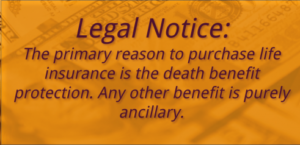You may have heard of – Infinite Banking Concept (IBC), Bank on Yourself, BYOB (Be Your Own Bank), 702 Plans©, etc.
One of the focus of our retirement planning business has been helping investors make more money.
The premise here is having a permanent life insurance that builds cash value. Permanent Life Insurance has Insurance (Death Benefit) + Cash Value (savings/investment feature that can earn interest).
However, with double play, you turn the concept on its head and turbocharge your passive investing strategy while building tax-free retirement vehicle, asset protection, estate planning, etc.
These Whole Life policies are designed for maximum cash accumulation and minimal insurance death benefit. In a properly designed policy about 85-90% of the premium goes straight to the cash value.
Key phrase here is – “policy loans against the cash value”!
Cash value can earn 5-6% tax-free (almost 9% taxable-equivalent basis in a product that can’t lose value!)
AND you can get a line of credit secured by that cash value at the then current rate of lets say 4.4%.
So any investment you can make with that loan amount that earns more than 4.4% will add value ON TOP OF the tax-free return on the cash value!
You can literally put your money to work in two places at one time.
This is like a having a “Magic Checking Account” where your bank account balance continues to grow and earn interest even after you write a check. In essence, it’s like having a credit line equal to the amount of money you keep in the bank. Try that with a real bank!
This is the most powerful financial strategy and it’s not something that is taught in business schools or is well-known.
We are simply taking advantage of the way life insurance works. It’s not even that we are taking advantage of it, this is the way life insurance was intended to work. Policyholders are supposed to have access to their cash value. Its written into the statutes of all 50 states.

